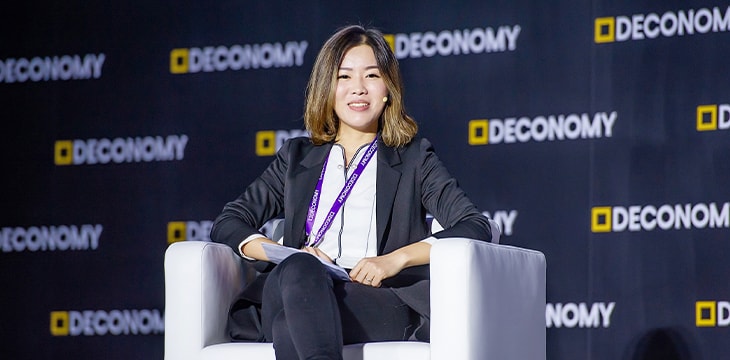|
Getting your Trinity Audio player ready...
|

Only Bitcoin SV (BSV) has achieved the scaling necessary for “serious business” and enterprise use, said Bitcoin Association Southeast Asia Manager Ella Qiang to an audience in the Philippines on Friday. Speaking as a guest in a webinar for local exchange PDAX, she explained BSV’s main advantages for both data processing and small-scale digital payments, while clarifying the main differences between BSV and other protocols calling themselves “Bitcoin“.
Host Nichel Gaba, CEO and founder of PDAX (Philippines Digital Asset Exchange) covered most of the major questions concerning Bitcoin BSV in the one-on-one interview, asking mostly about BSV’s ability to handle large amounts of data processing on-chain, centralization, and what prospects BSV had for those living in Asia and specifically, Southeast Asia.
Hello, the Philippines! https://t.co/GarxlfB9eL
— ella 🐻⛓️ (@ellaqiang9) December 11, 2020
Qiang said in Singapore, where she is mostly based, the focus is on financial and big data applications—whereas in the Philippines, it is mainly on payments and access to the digital economy for individuals. She referred to Philippines-based Pixel Wallet as a company to watch, and two local BSV projects which were important but “currently in stealth mode”.
Gaba appeared very receptive to BSV’s message and willing to hear it explained properly to his user audience, avoiding the usual questions about the identity of Satoshi Nakamoto and looking mainly at technological capabilities. Questions in the audience chat were concerned mainly with when Philippines residents could exchange and trade BSV (as expected, since PDAX is an exchange).
PDAX received clearance for a license to trade digital assets from the Bangko Sentral ng Pilipinas (BSP) in 2019, and trades digital assets for fiat, which can be deposited by credit and debit cards.
Bitcoin, centralization, miners and protocol developers
Gaba also asked several questions about the reasons for there being “three competing implementations of Bitcoin”—and invited Qiang to clarify the differences, since most of the audience might know only of BTC.
Qiang explained the initial block size/scaling debate that led to the 2017 BTC/BCH split, saying it defined the power balance between miners (whose incentives and actions secure the network) and developers, who exercised significant control over the protocol.
“You can’t allow a centralized group of people, whether they’re developers or miners, to tinker with the fundamentals of the protocol,” she said.
“Centralization” and “decentralization” in Bitcoin, she said, is not what many see it to be. Responding to a comment from Gaba that many think BSV mining/processing is too centralized, she pointed out that centralization occurs when a small group of developers are able to set or change the fundamental rules for the Bitcoin protocol (as happened on BTC), which is undesirable.
BTC and the Core development team were able to change the rules to turn Bitcoin into “digital gold,” a mostly-static asset that is slow and expensive to transfer and which isn’t very useful as a spending/payments tool.
BTC proponents saw “decentralization” as occurring in the miner community, assuming that thousands of small (even household) nodes could keep the network more secure. In fact, she pointed out, most of those small miners belong to mining pools and are better defined as “hashers.” Individually they do not produce blocks and therefore the pool itself is the only true node—making BTC, for all its size and market cap, not much bigger than BSV in terms of nodes securing its blockchain.
BSV returned power to the market, where it belongs, Qiang said. Likewise, when the later BCH/BSV split occurred in November 2018, the issue was how much control developers should have over the protocol. BSV set its rules in stone at that point, whereas BCH has undergone fierce debates and even another hard fork split over its protocol rules (and who gets to make them).
Moreover, BSV was the only chain that took scaling seriously, increasing its block size to 128MB, 2GB, and then finally removing all limits by February 2020. Those advances mean BSV’s ability to process data is now “unbounded,” freeing its ecosystem both from ideological debates and technological limits. Now, thanks to those conditions, BSV developers are free to build and discover new use cases.
She noted that BSV has been able to process around 4,000 transactions per second at its peak points this year, without seeing slowdowns or the kinds of fee increases networks like BTC and ETH have endured. BSV, with the release of enterprise-focused Teranode next year, has a goal to reach 50,000 transactions a second in 2021, and up to 4 million per second within the next five years.
Such capabilities are necessary for enterprise and “serious businesses,” she said. “If you don’t have that, then blockchain is just a buzzword.”
Gaba was also curious about the BSV community’s endeavors to find new use cases. Qiang replied that BSV’s large capacity and low fees (often around 1/100 of a U.S. cent) enabled new business models through micro- and even nano-payments—opening the door to machine-to-machine transactions between IOT devices sharing data and creating an entirely new economy.
BSV could also change the way data is managed and monetized on social networks, she said, citing problems with large corporations spending increasingly large amounts of money on data security, with diminishing returns.
Data privacy and ownership is also becoming an important issue, she added. While large social networks like Facebook and Twitter have made their money by selling their users’ data, BSV services like Twetch returned more control to the users, even allowing them to earn money from their own content.
Asked if BSV actually has the bandwidth to handle the big data use cases it proposes, Qiang said definitely—although companies will eventually decide what data they actually need to keep on-chain, and what could be processed as a hash of metadata, keeping records secure without needing to store all their data on-chain. Another new business model would be companies that store that extra off-chain data, she said, managing the connection between the front-end services and the BSV blockchain.
Overall the audience seemed interested in hearing more about Bitcoin BSV, and satisfied with the answers—and naturally, they’d like the ability to trade BSV too. Qiang and the Bitcoin Association have been active advocates in Asia, with more webinars and educational seminars on the agenda.
See also: CoinGeek Live panel, The Future of Exchanges & Trading in a Tokenized World

 12-14-2025
12-14-2025 





